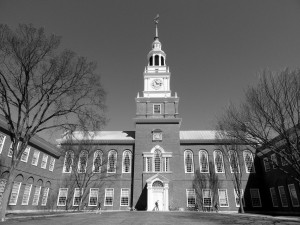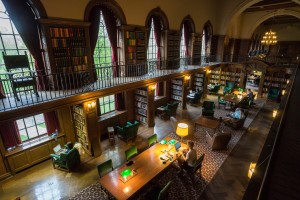In his book The Black Swan, Nassim Taleb uses the metaphor of Umberto Eco’s “antilibrary” to highlight our modern misunderstandings about collections of books. While some presume that Eco’s library of 30,000 books is a trophy case to display his reading prowess, Eco suggests that instead, a library is “not an ego-boosting appendage but a research tool… A library should contain as much of what you don’t know as your financial mean… allow.” The value of a vast untapped collection of books has never been lost on Dartmouth. For years, students, faculty, and the administration alike have seen the power that books give to institutions, and have made the acquisition of knowledge in paper form a key institutional priority. Today, it is hard to imagine Dartmouth College without its iconic Baker Tower at the head of the Green. However, the story of the Dartmouth’s libraries predates the grand clock tower by well over 100 years. Before Baker became the capitol of Dartmouth libraries, Dartmouth’s libraries lived in makeshift studies and home offices.

Baker Library: The centerpiece of Dartmouth’s campus and the Dartmouth experience. (Photograph courtesy of Wikimedia)
The history of Dartmouth’s Libraries starts much in the same way the rest of our college’s history: with Eleazar Wheelock. In fact, the original Dartmouth library was nothing more than a collection of Wheelock’s books. Wheelock then appointed a math and natural philosophy tutor, Bazeel Woodward, as the first Librarian of the college, and made the southwest chamber of Woodward’s home the library. With books, a place to keep them, and someone to look out for them, Dartmouth had its first library in 1970. As the library grew and encroached on Woodward’s living quarters, it became time for a new library in Old College, the principal college building of the time. This new library would be overseen by John Smith, who taught classics and oriental languages until he died in 1809. Besides teaching and running the library, Smith was the minister of the college church and owned a bookstore in Hanover. At this time, the role of Dartmouth Librarian was by no means a full time job.
In fact, it was students who developed early Dartmouth libraries. As the Revolutionary War drew to a close, literary societies made their way into fashion. On Dartmouth’s campus, the “Socials” and the “Fraters,” two societies on campus, began a fierce rivalry in literary debating. The groups collected dues and donations from members to build up their own rival libraries. The personal collections were likely needed because of the highly restrictive policy of the college library: a student had one hour per week to take out one book—that was it. When Dartmouth Hall replaced Old Dartmouth, the library moved to the new hall. There, each society received a room for its library. Organization of the library progressed with a printed catalogue in 1809, but the struggle between John Wheelock and the Trustees fragmented Dartmouth College into two disjoint entities: Dartmouth College and Dartmouth University (See The Storied History of Dartmouth).
While the trustees wished to keep the school a college, the state of New Hampshire awarded Wheelock’s Dartmouth University the library. The trustees refused to give up the ship, however, locking the room and refusing to surrender the key. The Library remained closed until the Dartmouth College Case was resolved. The literary societies remained at the center of books until 1817, when a professor at the university led a raid on the Socials’ library. The Fraters came to the defense of their rivals, ousting the invading professors. The literary societies stood their ground until the Supreme Court of the United States ruled in favor of the Trustees, students, and Dartmouth College.
After the court case, the College was in peril. Legal fees left the trustees looking to sell the College’s library, but, with no offers, the library remained unsold. The literary societies grew well past subsistence level and garnered great respect and generosity, while the library remained small. Eventually, it moved down to the first floor of Dartmouth Hall, in part to keep students from throwing books down the stairs. As the College Library remained the object of disrespect through the 1860s, the library closed, leaving no observable impact on the student body. The literary societies were still the center of Dartmouth’s collections. Edwin Sanborn returned order to the library system, finally incorporating literary societies into the College Library system and increasing operating hours. Fireproofing required the collection to leave Dartmouth Hall and move to Reed Hall until 1885, when Wilson Hall was designated to be the new College Library. Wilson Hall may have been the only project in College history to be constructed under budget and ahead of schedule.
The College seemed to have no plans for the much-needed expansion of Wilson until Oxford University debaters visited Dartmouth in 1925. At the beginning of his speech, one said that he was excited to see Dartmouth because he “had heard that the College had the largest gymnasium and the smallest library of any college in America.” President Earnest Hopkins later recalled that the jab “burned me up.” Hopkins began searching for donors and found Edwin Webster Sanborn, and George F. Baker. Sanborn was ready to donate a new library in memory of his late father, the college librarian from 1866 to 1874. Upon hearing that George F. Baker’s massive donation would dwarf his own, however, Sanborn balked in gifting his estate. It took considerable persuasion to convince Sanborn otherwise: while Baker would be an icon from the outside, Sanborn would be a gem on the inside. The new home of the English Department, Sanborn Hall, was erected in 1929 along with its neighbor Baker Library. Though Baker has evolved throughout the years, becoming home to the ever-expanding stacks as well as the ever-modernizing circulation, reserve, and reference desks, Sanborn’s hand-carved library remains a bastion of civility and tradition, with its continuing afternoon tea service and honor-based checkout system. President Hopkins presided over a time of great prosperity for the college, but he considered the construction of Baker and Sanborn libraries his greatest accomplishment.
In 1932, Dartmouth commissioned Mexican muralist José Clemente Orozco to plaster the bare walls of Baker’s basement with murals in the room that now bears his name. Alumni and trustees objected to the College’s decision to flaunt its wealth during the lean years of the Great Depression. The economic troubles of ensuing years caused a struggle between the administration and trustees as to whether the library should continue to expand. It wasn’t until economic trouble began to subside that the College Library would expand in full swing. When a weak dollar in 1938 left the library unable to acquire foreign books without donations, the College established a friends group, with voluntary dues, to fund gifts for the Treasure Room of Baker. As the depression grew to a close, Librarian Nathaniel Goodrich proposed a five-year expansion plan which would add to the stacks and the collections. The proposal faced opposition as trustees grew fearful that further expansion would fix something that wasn’t broken, or worse would transform Dartmouth College into Dartmouth University. When the Navy chose Dartmouth as the location of its Naval Reserve Officers Indoctrination School in 1942, the College added naval books to its collection in order to accommodate the new students. By 1950, at the close of Goodrich’s thirty-eight-year tenure, the Dartmouth College Library had acquired over 655,000 texts, and could no longer be considered the small library of the small College on the Hill. The next great addition to the library’s collection came from noted artic explorer Vilhjalmur Stefansson, who gave Dartmouth his great collection of texts, maps, and articles on the polar regions of the world. They were placed in Special Collections. The donation solidified the College as a leading institution in Geography and Arctic Studies. By 1962, the stacks had become a non-smoking area, catapulting them into the modern era. In the early seventies, Baker Library would play host to not just thousands of books but also streakers. Baker also played host to one of the College’s more controversial acts: in 1976, a man casually walked into
Baker with a shotgun to send his girlfriend a message, causing panic among the library patrons.
As Geisel, Thayer, and Tuck gained national prominence, their collections also grew; the centrality of Baker was in limbo. Eventually the different schools established their own libraries, increasing their collections and combining them into more appropriate departments. Medical books were moved to the Charles A. Dana Biomedical Library in the new medical building. The Tuck and Thayer collections were moved to the new Feldberg Library in 1973. As more and more books moved to departmental buildings in the school, Baker ended up holding only the Humanities and Social Sciences, but it remained the location of the administrative offices and processing departments for the entire library.
In 1979, Margaret Otto became the college’s first female librarian, breaking the male dominance of the position. In 1992, president James O. Freedman made an announcement that a thirty-million-dollar donation had been made to the College by John W. Berry ‘44, who Freedman called the greatest donor in the history of the College. Because of Berry and a few other donors, the Berry Library construction would begin, adjoined to the Baker Library. Ms. Otto was concerned that Baker and the other libraries on campus were not sufficient for the modern age and its technological advancements, and the Berry Library complex was the perfect remedy for her uncertainties. Freedman called it a “core resource for intellectual growth.” The donation was used for both the new library and a partial renovation of the Baker Library. Unlike Rauner, Berry was simply added to the north side of Baker. Phase one of construction finished most of the building in 2000, and in 2002 the renovations of Baker were completed.
Today, the Dartmouth College Library System houses millions of texts along with an immense online database. Books are kept everywhere from Baker and Sanborn to Feldberg and Berry. The Library is widely recognized as one of the best college libraries in the country, a far cry from the days of the original small library of the College on the Hill.


With all of those books it’s a shame that so few Dartmouth College students and grads know anything about the founding of the country and the principles upon which it was founded.
Astounding ignorance on The Grand Scale.
Yeah-but if you KNOW anything but the Party Line about America, /you could lose your membership status for heresy!